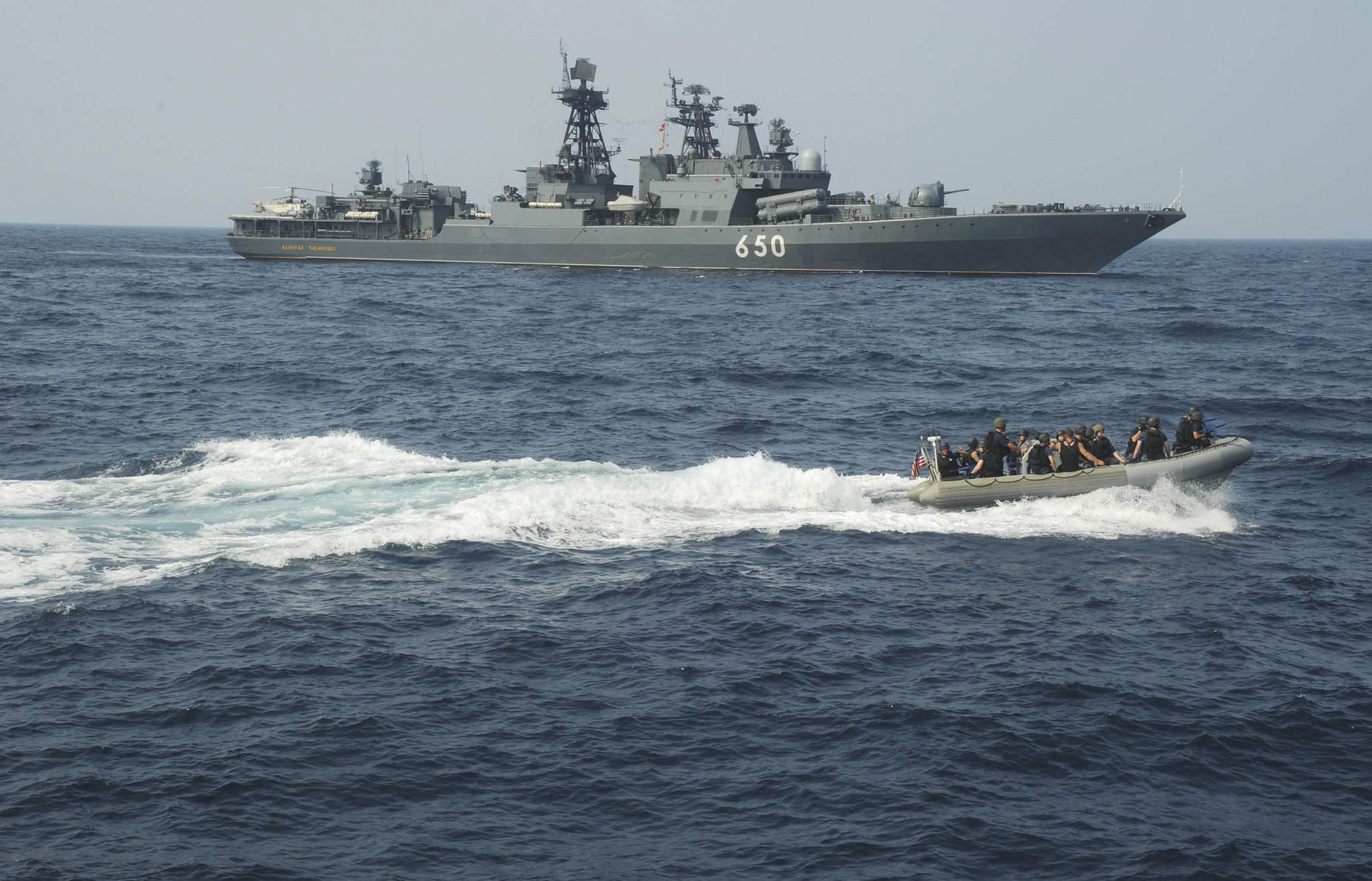Pirate attacks worldwide
2021: 125?
2020: 195
2019: 162
2012: 297
2010: 445
A terse description of a high-seas pirate attack off Nigeria three weeks ago, from the International Maritime Bureau’s Piracy Reporting Centre:
Oct. 25, 2021: While underway, a container ship was boarded by an unknown number of pirate and the crew retreated into the citadel. On being notified of the incident, the IMB Piracy Reporting Centre immediately alerted and liaised with the Regional Authorities and international warships to request for assistance. A Russian Navy warship and its helicopter responded and proceeded to render assistance resulting in the crew and ship being safe. The pirates escaped with stolen ship’s properties.
Background: A decade of naval cooperation, even among distrustful big powers, appears to have made high-seas pirate work more difficult and less rewarding.
In 2010, international waters off Somalia — the Red Sea, the Gulf of Aden, and the ‘Bab-el-Mandeb’ strait, the principal commercial and energy link between Asia and Europe, with 50 ship transits and 3.4 million barrels of oil moving daily — were the center of the pirate industry. The collapse of Somalia’s central state in 1991 left country prey to sequential waves of violent clan-based militias, radical fundamentalists and crime gangs. One product of this was a notorious high-seas pirate industry; at its peak from 2005 to 2010, gangs using small speedboats and automatic weapons were attacking three or more ships a week on the high seas — in total, 181 attacks in 2009 — and in 2010 they were holding 30 vessels and 600 sailors for ransoms ranging up to $95 million.
Since then, the 29-country naval patrol known as CTF-151 (“Combined Task Force 151”) with rotating commands led this year by Pakistan and now Brazil, appears to have essentially eliminated the Somali pirate industry. The last two successful attacks on high-seas vessels in this region were in 2017, and the most recent failed attempt was in 2019; none at all are reported for 2020 and 2021.
On a worldwide scale, pirate attacks have fallen by over half in the past decade, from 445 known attacks in 2010 to 195 in 2020. The running tally kept by the International Maritime Bureau in Kuala Lumpur suggests that this year’s count may fall below 150, which would be the fewest attacks since 1994. Piracy is now most frequent in Indonesia and in the Singapore Strait, the sites of 47 of last year’s 161 attacks and 25 of the 97 attacks reported through September 2021. Only two of these, though, were actual attacks on high-seas shipping; the others were attempted robberies of ships in port or at anchor. Attacks off West Africa are somewhat less frequent — 24 in 2020, or two each month — but appear to feature especially well-armed and violent pirates, responsible for all three 2020 high-seas hijackings of ships, along with 128 of the 135 crew kidnappings, and nine of the 11 incidents of firing on shipping. In West Africa too though, frequency and severity have diminished this year, with the open-water event off Brass last month the only high-seas attack recorded so far. Its quick interruption by a Russian naval patrol, even though the pirates got away with some stolen equipment, suggests some success for international naval cooperation here as well.

Facts and data
The International Maritime Bureau’s piracy reports for 2020 find:
Totals: 195 pirate attacks of all kinds worldwide, down from a peak of 445 attacks in 2010, and down again by 30% (from 132 to 97) through the first nine months of 2021.
Hijackings: 11 hijackings of high-seas shipping, down from 53 in 2010; only two so far in 2021.
The International Maritime Bureau on recent pirate attacks, with the full-year 2020 and partial-year 2021 reports available at no cost via e-mail:
Navy perspectives
Command Task Force 151, led last year by Pakistan and this year by Brazil, patrols Somali waters.
The Marinha do Brasil takes over CTF-151.
And the U.S. Navy reports on joint anti-piracy training with the Ghanaian navy this spring, and Ghanaian-American sailors Samuel Ellis and Prince Boateng visiting home.
The Singapore-based Information Sharing Center for the Regional Cooperation Agreement on Combating Piracy (RECAAP) oversees anti-piracy operations in maritime Southeast Asia.
Two views on Somali piracy
Brookings Institution scholars speculate on a link between illegal/unreported/unregulated fisheries and piracy rates, can be read here.
And a personal account from journalist Michael Scott Moore in The Guardian, on his 977 days as a pirate kidnap victim can be read here.
Ed Gresser is Vice President and Director for Trade and Global Markets at PPI.
Ed returns to PPI after working for the think tank from 2001-2011. He most recently served as the Assistant U.S. Trade Representative for Trade Policy and Economics at the Office of the United States Trade Representative (USTR). In this position, he led USTR’s economic research unit from 2015-2021, and chaired the 21-agency Trade Policy Staff Committee.
Ed began his career on Capitol Hill before serving USTR as Policy Advisor to USTR Charlene Barshefsky from 1998 to 2001. He then led PPI’s Trade and Global Markets Project from 2001 to 2011. After PPI, he co-founded and directed the independent think tank ProgressiveEconomy until rejoining USTR in 2015. In 2013, the Washington International Trade Association presented him with its Lighthouse Award, awarded annually to an individual or group for significant contributions to trade policy.
Ed is the author of Freedom from Want: American Liberalism and the Global Economy (2007). He has published in a variety of journals and newspapers, and his research has been cited by leading academics and international organizations including the WTO, World Bank, and International Monetary Fund. He is a graduate of Stanford University and holds a Master’s Degree in International Affairs from Columbia Universities and a certificate from the Averell Harriman Institute for Advanced Study of the Soviet Union.